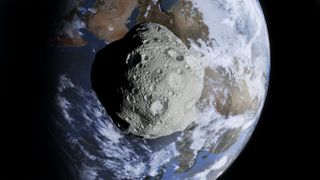NASA upgrades its asteroid hazard software to use sunlight
Key changes will make hazard prediction better — not that we need to worry yet.

NASA's Jet Propulsion Laboratory (JPL) just upgraded the software it uses to assess potentially hazardous asteroids to account for sunlight's affect on orbits, among other changes.
While there are no immediate known space rock hazards to Earth despite decades of careful searching, astronomers continue to scan the skies, just in case. The new impact monitoring algorithm, called Sentry-II, upgrades software in use for 20 years.
Like its predecessor Sentry, the newer Sentry-II will periodically scan a table of potentially hazardous asteroids with known orbits, generated by the Center for Near Earth Object Studies managed by JPL.
Photos: Asteroids in deep space
Sentry-II will make calculations into at least the next decade, reporting the objects with calculated orbits most at risk to Earth. (Another system called Scout assesses those asteroids with only partially known orbits.)
But Sentry-II also includes a key upgrade that will make its assessments more accurate: taking into account the Yarkovsky effect.
The Yarkovsky effect happens when sunlight is absorbed by the surface of the asteroid and re-emitted as heat. This heat emission has a subtle, but powerful effect on the path of an asteroid through space — and may affect the space rock's probability of hitting Earth.
Get the Space.com Newsletter
Breaking space news, the latest updates on rocket launches, skywatching events and more!
Astronomers have known about the Yarkovsky effect for decades, however, it's only recently that computer software became powerful enough to handle analyzing the effect on large datasets. Sentry-II will allow JPL to assess potential impacts with odds as small as a few chances in 10 million, the agency said.
"The fact that Sentry couldn't automatically handle the Yarkovsky effect was a limitation," Davide Farnocchia, a JPL navigation engineer who also helped develop Sentry-II, said in a statement.
The lack of Yarkovsky calculations in the original Sentry system meant that astrophysicists had to do manual analyses every time they ran across a "special case" asteroid, Farnocchia noted. One of the more famous examples was asteroid Apophis, which needed manual assessment for the Yarkovsky effect to figure out how likely a 2068 impact from this asteroid was. Happily, last year NASA determined the 2068 flyby of Apophis will be harmless.

The older system had another limitation as well, in that it couldn't always predict the impact probability of asteroids swinging extremely close to Earth. Sentry-II allows for a more robust set of calculations that accounts for the significant effect Earth's gravity has in such situations, NASA said.
Additionally, Sentry-II predicts orbits with fewer assumptions about which ones are the most likely one an asteroid will take, allowing the algorithm to find low-probability impact scenarios its predecessor might have missed.
Sentry-II will come into its own as larger and more capable survey telescopes come online in the next decade, NASA said. There are nearly 28,000 known near-Earth asteroids and observatories are already adding more discoveries at a rate of about 3,000 per year, NASA said. This pace of discovery will accelerate as the decade continues.
Among those new observatories will be the Near-Earth Object (NEO) Surveyor mission, whose expected 2026 launch will at last provide a dedicated spacecraft searching for asteroids. NEO Surveyor is expected to discover 90% of near-Earth asteroids 460 feet (140 meters) in size or larger within a decade of its launch.
Another highly anticipated asteroid-hunting observatory, based in Chile, is the Vera C. Rubin Observatory. Formerly known as the Large Synoptic Survey Telescope, Rubin is expected to see first light in July 2023. The U.S. National Science Foundation funded Rubin to, among other tasks, search for potentially hazardous asteroids through looking at the same area of the sky hourly, seeking objects that changed position.
A study describing Sentry-II was published in the Astronomical Journal on Dec. 1, 2021.
Follow Elizabeth Howell on Twitter @howellspace. Follow us on Twitter @Spacedotcom and on Facebook.
Join our Space Forums to keep talking space on the latest missions, night sky and more! And if you have a news tip, correction or comment, let us know at: community@space.com.

Elizabeth Howell (she/her), Ph.D., was a staff writer in the spaceflight channel between 2022 and 2024 specializing in Canadian space news. She was contributing writer for Space.com for 10 years from 2012 to 2024. Elizabeth's reporting includes multiple exclusives with the White House, leading world coverage about a lost-and-found space tomato on the International Space Station, witnessing five human spaceflight launches on two continents, flying parabolic, working inside a spacesuit, and participating in a simulated Mars mission. Her latest book, "Why Am I Taller?" (ECW Press, 2022) is co-written with astronaut Dave Williams.
Most Popular


